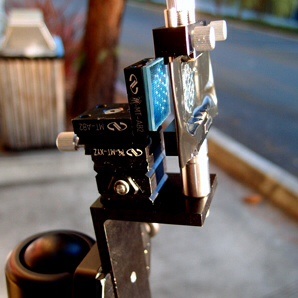Saw this tonight. Seems pretty interesting....
Adaptive Material Could Cut the Cost of Solar in Half
A new material, combined with a cheap tracking system, could unleash the promise of concentrated solar power.

By Kevin Bullis on July 30, 2014
WHY IT MATTERS
Cheaper solar power would help address climate change.
Sun tracker: Small lenses focus sunlight onto an adaptive material that helps track the movement of the sun.
A material with optical properties that change to help it capture more incoming sunlight could cut the cost of solar power in half, according to Glint Photonics, a startup recently funded by the Advanced Research Projects Agency for Energy (ARPA-E).
Glintís adaptive material greatly reduces the cost of a tracking system used in some types of solar power. It changes its reflectivity in response to heat from concentrated sunlight in a way that makes it possible capture light coming in at different angles throughout the day.
Itís well known that focusing sunlight makes it possible to use smaller, cheaper solar cells. But this is usually done with lenses or mirrors, which must be moved precisely as the sun advances across the sky to ensure that concentrated sunlight remains focused on the cells. The equipment required for that and the large amount of steel and concrete needed to keep the apparatus steady makes the approach expensive.
Glintís light concentrator has two parts. The first is an array of thin, inexpensive lenses that concentrate sunlight. The second is a sheet of glass that serves to concentrate that light moreóup to 500 timesóas light gathered over its surface is concentrated at its edges.
The sheet of glass is covered with reflective materials on the front and the back that trap light inside the glass. One of these sides features the new adaptive substance made by Glint. When a beam of concentrated light from the array of lenses hits the material, it heats up part of it, causing that part to stop being reflective, which in turn allows light to enter the glass sheet. The material remains reflective everywhere else, helping to trap that light inside the glassóand the light bounces around until it reaches the thin edge of the glass, where a small solar cell is mounted to generate electricity.
As the day goes on, the beam of light from the lenses moves and the material adapts, always allowing light in only where the beam of light falls, and reducing the need to keep the apparatus pointed directly at the sun.
Glintís CEO Peter Kozodoy says solar power from its devices could cost four cents per kilowatt-hour, compared to eight cents per kilowatt-hour for the best conventional solar panels. This month, the company received the first installments of a $2.2 million grant from ARPA-E. The ARPA-E funding will allow the company to scale up from prototypes just 2.5 centimeters across to make 30-centimeter modules, nearly large enough for commercial operation.
Howard Branz, a program director at ARPA-E, says the main remaining challenge is increasing the amount of sunlight that makes it to the solar cells, something that needs to be improved over the proof-of-concept device, in which some of the light is absorbed or reflected en route to the solar cells.
Gain the insight you need on emerging technologies at EmTech MIT.
Register today